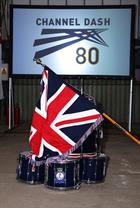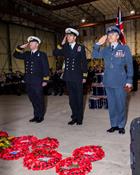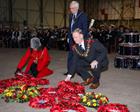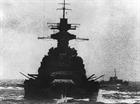A final salute to the heroes of the Channel Dash
Fliers from 825 Naval Air Squadron remembered the most stirring moment in the formation’s history.
Eighty years almost to the minute that six Swordfish torpedo bombers lifted off from Manston airfield in Kent, nine personnel from the Wildcat squadron, led by Commanding Officer Commander Hugh Saltonstall, joined family members, friends, veterans groups and enthusiasts paying tribute to the heroes of the Channel Dash.
Around 150 people - including sailors from HMS Kent (paying a weekend visit to her ‘hometown’ of Dover just down the coast) and HMS President, Sea Cadets from Ramsgate, the RAF’s Central Band and representatives of 72 Squadron (which trains the fast jet pilots of tomorrow) gathered in a hangar on the edge of the now-dormant airfield for the last major act of recognition, reconciliation and remembrance honouring men who tried against the odds to stop a breakout by the German Fleet.
In the dark days of February 1942, three German heavy ships - battle-cruisers Scharnhorst, Gneisenau and cruiser Prinz Eugen - plus a thick ring of escorts and protective umbrella of Luftwaffe fighters broke through the Channel from their base at Brest to Germany.
On the afternoon of February 12, the Royal Navy and Royal Air Force made concerted efforts to stop the ships, beginning with a near-suicidal attack by six Swordfish bombers of 825 NAS, temporarily operating from the RAF station.
None returned. All but five of the 18 aircrew were lost. No hits were scored on the enemy ships as the Swordfish were blasted out of the squally Channel skies by German fighters and naval anti-aircraft guns.
The Swordfish may be large and lumbering - top speed 90kts/100mph when weighed down by a torpedo - but it was proven weapon which had twice changed the course of the war, crippling the Bismarck and knocking out the kernel of the Italian Fleet at Taranto.
“The Swordfish was proven capability. Had it received the proper fighter protection on the day, who knows what would have happened,” said the squadron’s senior observer Lieutenant Commander Douglas Keenan.
“Instead it was outgunned, outpaced, outpowered, outnumbered. It’s like an aerial version of the Charge of the Light Brigade.
After spending most of the past 70 years dormant, save for brief re-births in the early 60s and the Falklands, 825 stood up again in 2014, and personnel immediately sought stand-out deeds in its history.
“Everyone on the squadron is familiar with the Channel Dash,” Lt Cdr Keenan added. “The Swordfish is raw aviation - imagine being up there. It’s cold. It’s slow. You’re in bulky clothing, it’s Biggles-esque. Everything is manual. Flying a ‘stringbag’ there were no bells or whistles.”
Carol Lee’s late husband Edgar was just 20 and the only man in Swordfish ‘G’ not to be wounded when it was shot down having made a torpedo run, probably against the Gneisenau, and subsequently crashed into the Channel. Lee freed himself, then his badly-injured pilot Brian Rose, helping him into a dinghy. He could do nothing for gunner Ambrose Johnson, slumped over his gun and trapped in his seat. The Channel swallowed the Swordfish whole, taking Johnson with it.
A quiet, modest man like all of his generation, Edgar Lee only came to talk about his wartime experiences decades later when historians and associations began to show renewed interest in the action, especially the Channel Dash Memorial Trust whose efforts especially over the past dozen years had done so much to keep the memories alive.
“Edgar was never a man to put himself to the fore, but he would have been proud and above all really would have appreciated that people still remember,” Mrs Lee said.
“People need to remember what they did - thanks to the events like this, the work of the trust and the memorials in Ramsgate and Dover, those men, their bravery and sacrifice, will always be remembered.”
The 18 aircrew are remembered on the 825 NAS memorial in Ramsgate, erected in 2010. But the Dash was a concerted effort by air and sea.
Twenty-seven sailors in HMS Worcester were killed in a ‘death ride’ against the enemy ships later that afternoon, while more than 100 RAF aircrew were killed in attacks every bit as hazardous and ineffective as the attempts by the Swordfish.
Around 30 wreaths were laid in the hangar following a drumhead service; they were re-laid the following day at the Operation Fuller - the codename for the efforts to stop the breakout - monument in Dover.
The memorial - like the one in Ramsgate - is a permanent legacy of the Channel Dash Memorial Trust which was formed with three key themes in mind: recognition, reconciliation - Germany and the German Navy were represented - and remembrance.
Having achieved those goals, its chairman and former sailor Malcolm Godfrey said the 80th anniversary was an apt moment to hold the final major act of commemoration.
“For many years the Channel Dash was seen as a failure - it’s only more recently that we have come to celebrate and recognise acts of selfless bravery,” he added.
“Eighteen men got into those aircraft knowing that they would probably not come back. Their actions demonstrate the bravery which we like to think we possess in ourselves in the hardest hours.”
You can learn more about the Channel Dash in our special feature: https://www.royalnavy.mod.uk/news-and-latest-activity/news/2021/february/12/20210212-channel-dash






